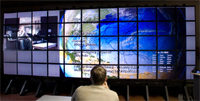SAGE SC06 Visualcasting Demonstration
November 12th, 2006 - November 16th, 2006
Categories: Applications, MS / PhD Thesis, Networking, Software, Supercomputing, Visualization

About
An Application-Centric Service To Create Virtual Laboratories for Global Collaboration
Visualcasting is a new SAGE network service that enables two or more remote users to interact with one another, as well as with their data, at the same time. Users need to see one another and to see the same content to effectively work together over distance. The technology currently used to broadcast information to two or more sites is called multicast, and while effective, today’s networking infrastructure does not automatically support it, and requires network engineering to implement.
Visualcasting addresses this problem by enabling applications to select what information to send, and to whom to send it, without the need for technical support and network modifications. Moreover, visualcasting supports endpoint displays of variable size and configuration. Visualcasting is application-centric, enabling researchers to dynamically create their own virtual laboratories for global collaboration.
At SC06, EVL showcases its SAGE visualcasting software. EVL creates a virtual laboratory with other SC06 research booths connected via 10Gbps links to SCinet, and with national (and international) sites via National LambdaRail.
Each endpoint runs SAGE to send and/or receive real-time streams of ultra-high-resolution 2D and 3D content. Visualcasting manages the streams so the same content is made available to all participants. Visualcasting is supported by a bridging system that receives pixel streams from SAGE applications and replicates these streams to each endpoint. Visualcasting nodes are strategically placed in core network facilities and allocated to service distant collaborators.
At SC06, EVL showcases its SAGE visualcasting software. EVL creates a virtual laboratory with other SC06 research booths connected via 10Gbps links to SCinet, and with national (and international) sites via National LambdaRail.
For the demo, multiple collaborators share high-resolution content and participate via video conferencing. (Note: Not all groups are participating at the same time.) At the time of publication, participating groups include:
- Calit2 / CEOA - EVL is conducting SAGE Visualcasting demonstrations at this booth.
- Dutch Research Consortium - SARA High Performance Networking & Insight Services Group
Content to be shown includes animations from NASA; simulations from Louisiana State University, UCSD Scripps Institution of Oceanography and UCSD National Center for Microscopy and Imaging Research; scientific visualizations from the National Center for Supercomputing Applications; and, climate data from SARA.